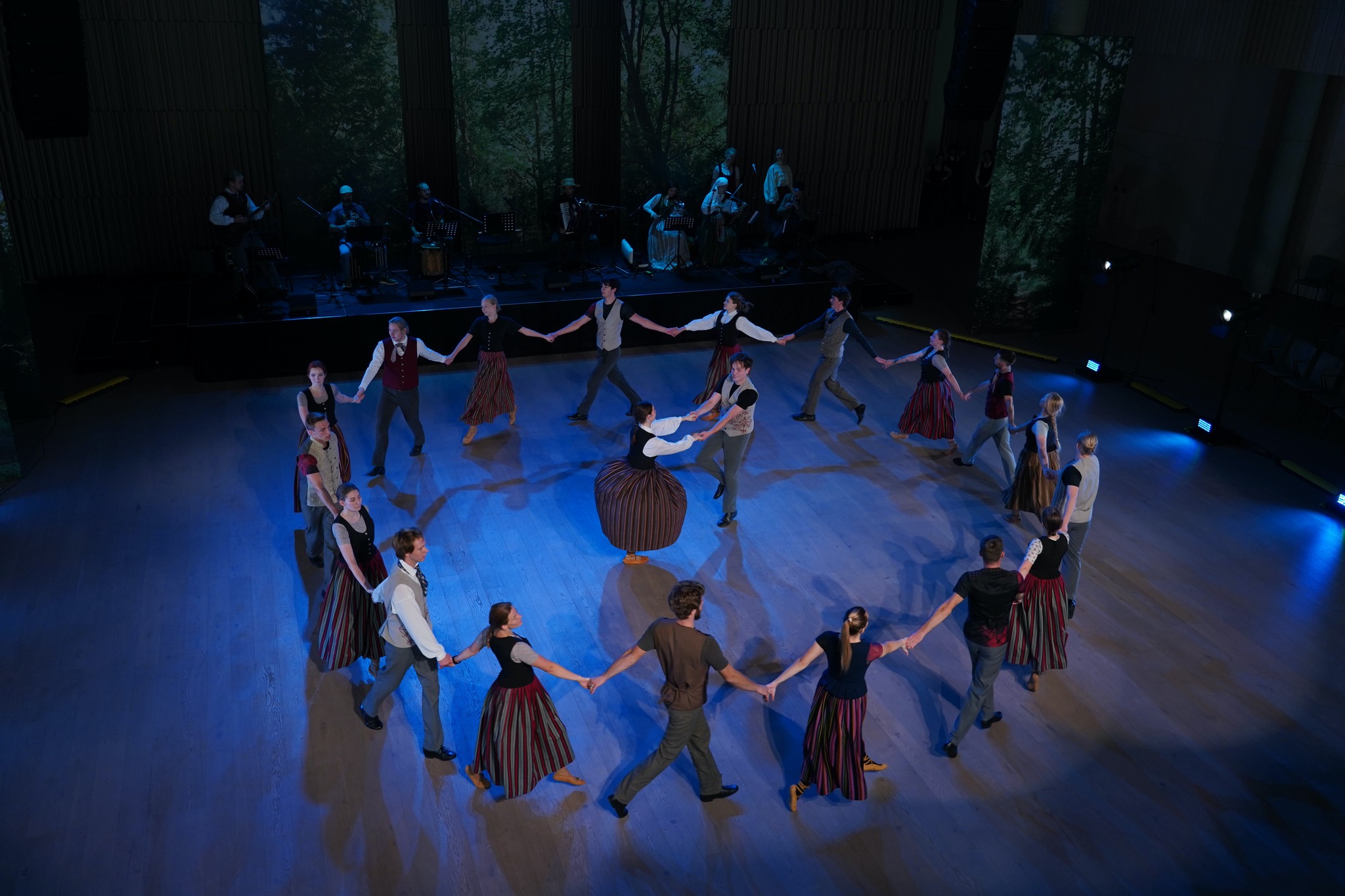
From October 5th to 8th, I attended dance events in Latvia at the invitation of The Latvian Dance Information Center (LDIC). It was a showcase of two works by Rado Poklitar: “Viy. Night of Horror” and “Dance to Live, together with “Aunt Anna’s Pirouettes” by choreographers Lilia Lipora, Ilmars Drels, Reinis Reshetins.
Since I am a folklorist by my first master`s degree, I always value getting to know the folk culture of the country I visit. I combine my knowledge of folklore, art, and psychology to uncover the meanings behind various artistic works. That’s why I immediately wanted to attend the concert-show “ANNAS TANTES PIRUETES” performed by JDK “Dārdari”, who are celebrating their tenth anniversary this year.
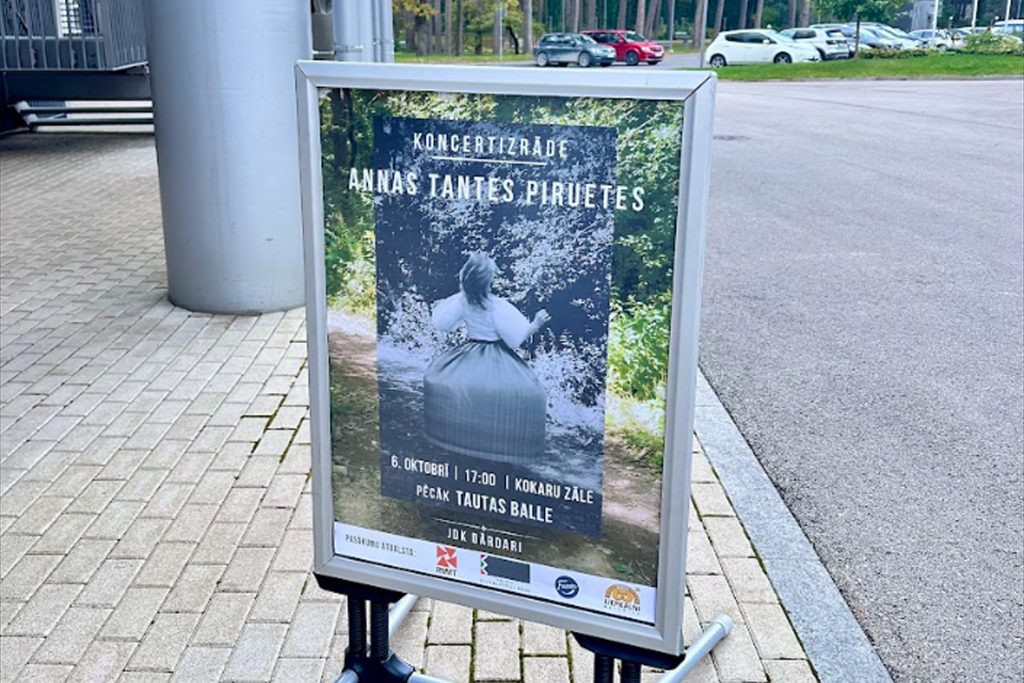
Dialogue of cultures: reflections on Latvia and Ukraine
I didn’t know much about Latvia beforehand but here, it seems that thanks to the concert-show, I immediately fell in love with Latvian folklore. First and foremost, I was intrigued by the brief announcement of the performance, which mentioned that it is an interdisciplinary production combining Latvian folk dance, traditional singing, and theater. It made me wonder: how often can we encounter similar works in Ukraine? We have many theatrical productions based on famous works by Ukrainian authors, such as “Kaidash’s Family” based on the story by Nechuy-Levytsky or “The Forest Song” by Lesya Ukrainka, which indeed allow us to understand Ukrainian folk culture to some extent. However, they are primarily based on the theatrical aspect. And here, in “Aunt Anna’s Pirouettes,” dance, folk singing, and music truly form the foundation. Yes, I didn’t understand the Latvian language, but I believe I was able to feel the folk culture precisely because folklore dominated, rather than theatrical rituals or something else. Therefore, one more fan of Latvian folk creativity has emerged. I consider it a great move!

Certainly, performances like “Shadows of Forgotten Ancestors” and evening gatherings where you can see more folk dances and songs from the Kyiv Academic Theater of Ukrainian Folklore “Beregynya” hold great value: the audience gets to experience authentic Ukrainian culture without any “sharovarshchyna.” It seems that there is no direct equivalent term in English or Latvian for “sharovarshchyna.” “Sharovarshchyna” refers to the portrayal of a superficial, simplified, or commercialized version of folk culture, often including fake elements of daily life and attire. In particular, “sharovarshchyna” promotes Ukrainian culture as something exclusively associated with rural areas and simplifies it to the understanding of Cossacks. It emerged during the Soviet expansion. Therefore, when considering folklore in Ukraine today, it is important to “filter” it for oneself.
Exploring Latvian folk dances, singing, and music, I became interested in the influence of the Soviet era on Latvian folk culture, as similar processes occurred in many countries, leading to the formation of a so-called shared Soviet identity rather than an ethnic one. During my visit to Riga, one aspect saddened me: the expansion of the Russian language in the capital. It made me wonder to what extent this country preserves its folk culture, language, history, and its own identity. There are various statistical data, and according to some of them, before the full-scale invasion in 2022, Ukraine had around a 30% Russian-speaking population. According to Putin’s version, it was this population that Russians came to “save.” The language issue remains a subject of debate: is it about roots, connection to the homeland, or is it simply an individual choice, while everything else is propaganda manipulation?
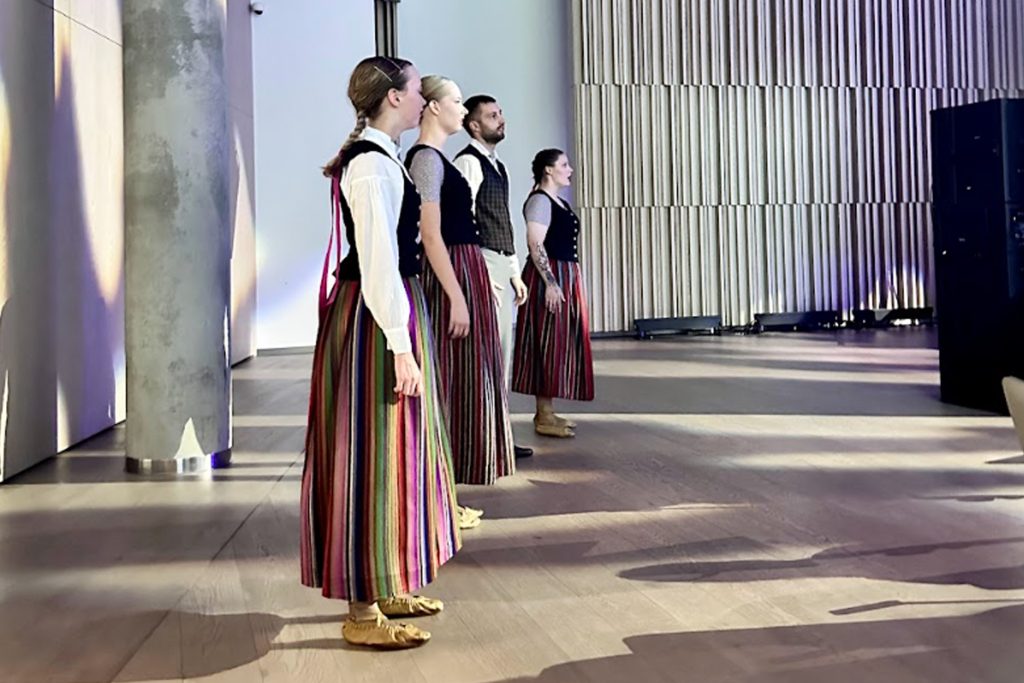
This is your pirouette!
The concert-show “Aunt Anna’s Pirouettes” is dedicated to honoring ancestral heritage and addresses the question of how to embrace death while celebrating life. The love for Aunt Anna, who passed away a year ago, immediately catches attention with the words, “This is your pirouette! You are capable of it! Just believe in yourself and act!” Thus, everyone on the stage this evening tries to showcase their own pirouette.
Watching the concert-show has inspired me to further explore the intricacies of Latvian folklore. I learned about the folk celebration to honor ancestors. People visit the graves of their relatives, decorate them with flowers, light candles, and perform religious rituals. This typically is observed in the autumn, usually on the last Sunday of September or the first Sunday of October. This festival helps maintain a connection with deceased family members. It also has a mythological background. In Ukraine, on the other hand, the commemoration of the deceased took place in the spring, and all the rituals were associated with the day of the spring equinox. This holiday was called “Radovnytsia,” and researchers even suggest that it lasted for a whole week. However, with the adoption of Christianity, only one day was left – the Sunday following Easter.

I mentioned evening gatherings and other Ukrainian folk traditions because, during the full-scale invasion by Russia, Ukrainians began to pay more attention to them. They started to question their cultural and national identity. Ukraine is rich in folklore, which varies from one region to another. Even in neighboring villages, dialects and the execution of the same rituals can differ. Sometimes, it may truly seem that we are very different within one country. So, the question that arises is: what unites us? I cannot speak for the entire country, but I can express my own opinion. Knowing Ukrainian and world folklore, what unites me is ornamentation. The patterns are embroidered on clothing, painted on houses or pottery, and so on. The figures that our ancestors depicted in folk dances, which we continue to carry on. It is a combination of solar (sun) and lunar (moon) symbols. Our mythological (pre-Christian) roots are what unite us, but unfortunately, they have been partially lost already. And, of course, modern folklore. You know that stories about dreams are a part of folk creativity that is still alive today, right? I have researched the cult of ancestors through the interpretation of dreams (oneiric narratives), and I can confidently say that a young man from the east of Ukraine and a grandmother from the west will see something similar in their dreams, with shared symbols.
Returning to the topic of the winter solstice, in Ukraine, we have the celebration of Kalita associated with it. Kalita is a ritual bread that is baked on St. Andrew’s Eve (November 30th). It symbolizes the sun and prosperity. The ritual itself marks the farewell to autumn and the arrival of the winter solstice. It also involves divination for one’s fate. Traditions of festivals related to fate and fertility are important in both Ukrainian and Latvian cultures.

Mythological beliefs often involve a close connection between generations and a belief in the cyclical nature of time. In the concert-show “Aunt Anna’s Pirouettes,” various folk dances were showcased, many of which included choreographed circular movements. However, what impressed me the most were a few moments when one of the girls walked on the hands of others and was later carried by them. In Ukraine, we have similar dance elements in our “vesnyanku” (spring songs) where we bid farewell to winter and welcome the arrival of spring.
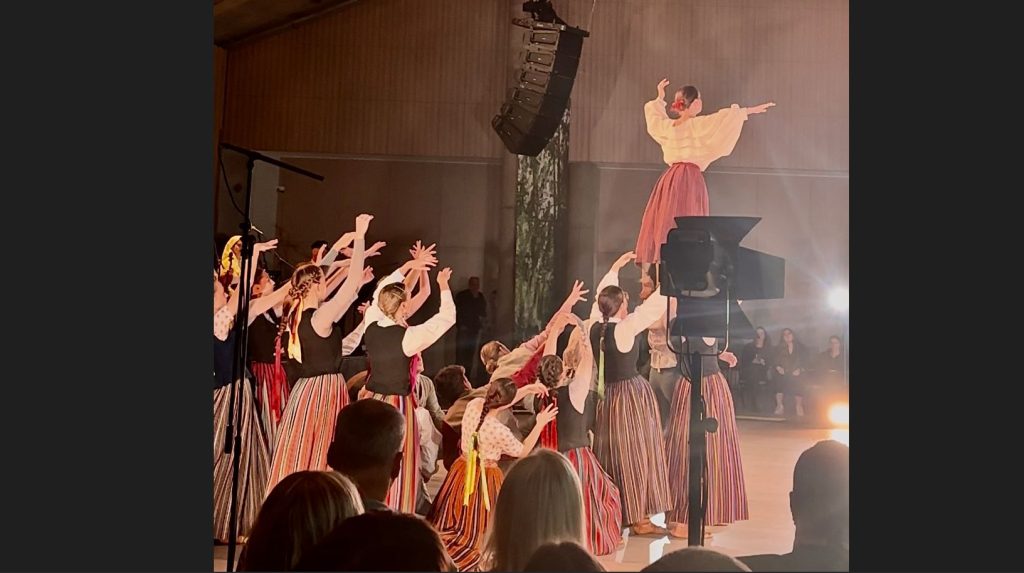
Among the performances, there were also traditional folk dances, and indeed, there were certain similarities with Ukrainian folk dance, such as the Ukrainian dance “Oyra”. Similar features between Latvian and Ukrainian dances included dancing in circles, spinning in pairs, changing partners, precise footwork with accents, and jumps. The dancers also formed “gates” through which they passed one by one.
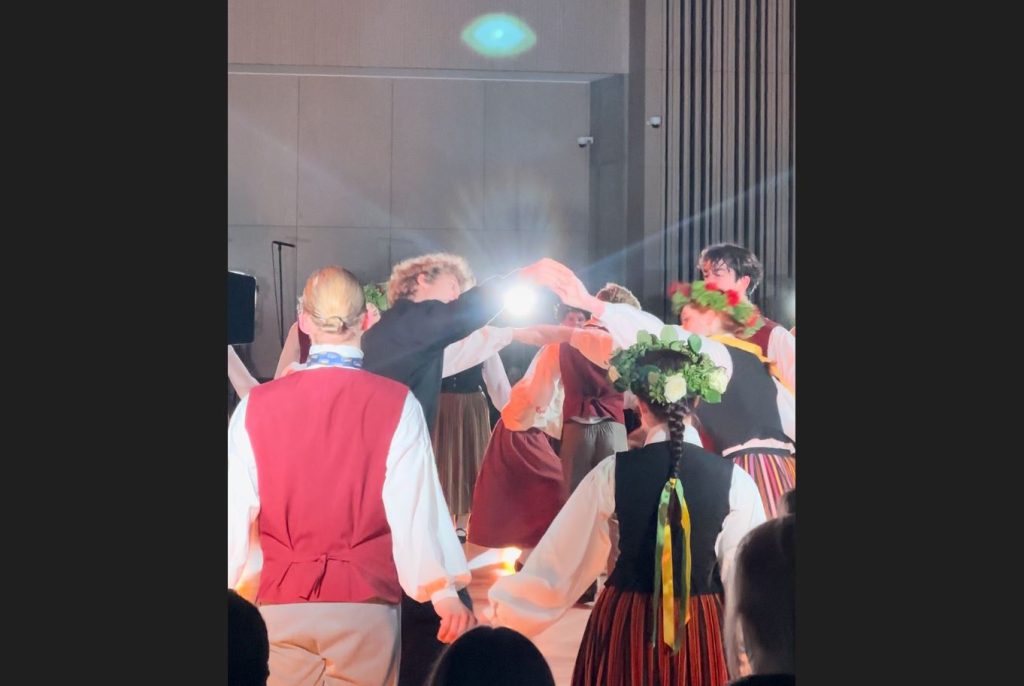
It’s interesting to note that even the dance known as “Kryvyi tanets” in Ukraine, which involves an imitation of snake-like movements, has similarities. We consider this dance to be very ancient, embodying the belief of our ancestors that time is not linear but cyclical, reinforcing the belief in the connection between generations.

I cannot fail to mention the musical accompaniment by composer Edgars Lipors, who created original music and arrangements of folk music, performed by “Dārdaru muzikanti” together with musicians Baiba Ergle, Janis Saussnit, and Artis Lipors. The music truly touches the soul! Especially the sound in combination with the vargan (jaw harp), which is also present in Ukraine. It seemed that from the very beginning of the performance, I wanted to join the dancers: the movements were so harmonious, and the music was so evocative.
“This is my pirouette, too”, I thought, and I went on to continue exploring this beautiful world, inspired to express myself.
Choreography: Lilija Lipora, Ilmārs Dreļs, Reinis Rešetins
Music: Edgars Lipors, Baiba Ērgle, Janis Sausnītis
Set design: Marija Rozīte-Vītola
Costume designer: Sanita Pūciņa
Actors: Edgars Lipors, Inese Buravceva, Gusts Dūšelis, Katrīna Dišlere, Dzintars Lipors, Dārta Dūšele and others.
Author of the photos: Anna Liudnova